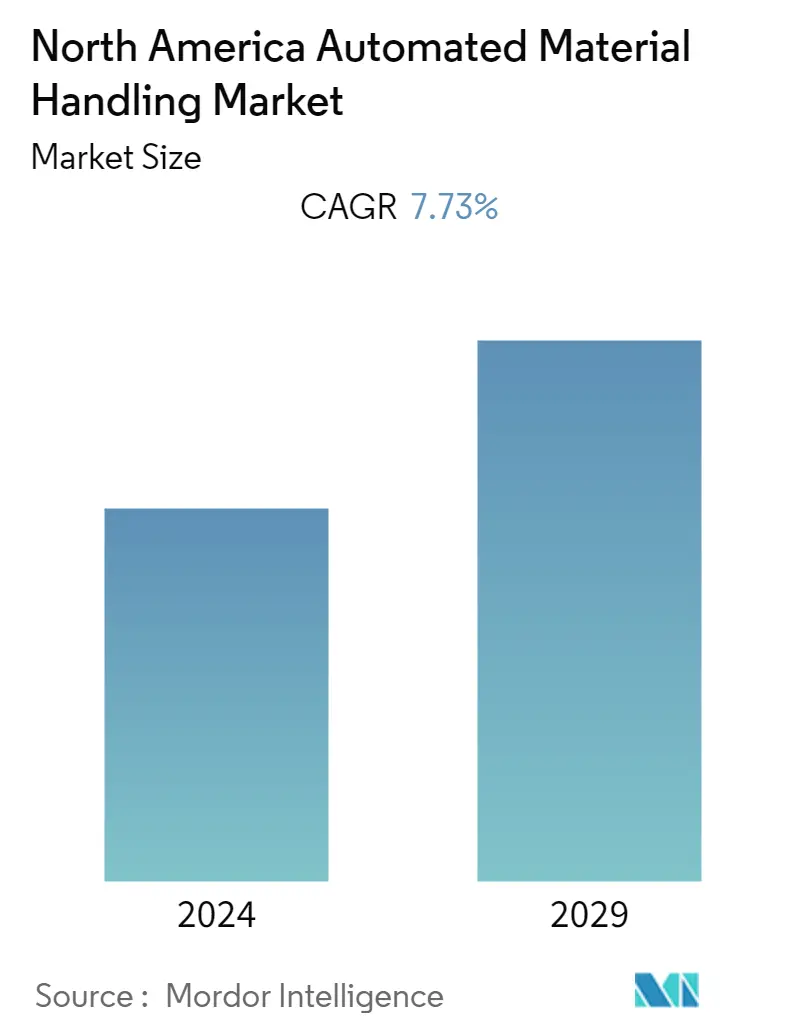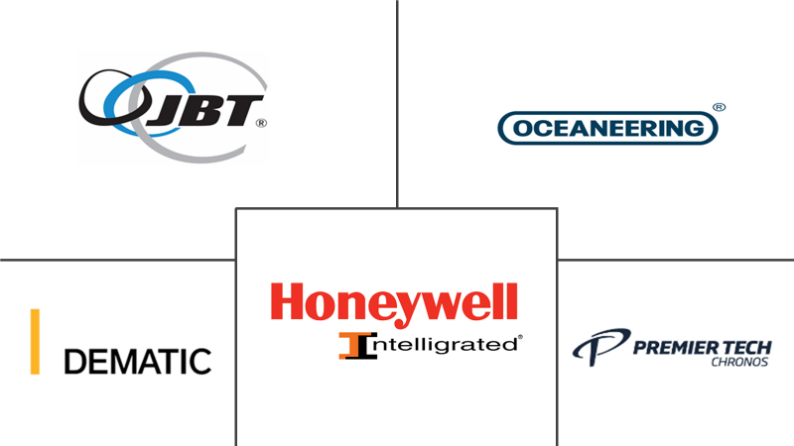Market Size of North America Automated Material Handling Industry

| Study Period | 2019 - 2029 |
| Base Year For Estimation | 2023 |
| Forecast Data Period | 2024 - 2029 |
| Historical Data Period | 2019 - 2022 |
| CAGR | 7.73 % |
| Market Concentration | Low |
Major Players
*Disclaimer: Major Players sorted in no particular order |
North America Automated Material Handling Market Analysis
The North America Automated Material Handling Market is expected to register a CAGR of 7.73% during the forecast period. Automated material handling is a concept derived from material handling practices, which uses several types of machinery to help workers in a manufacturing establishment move the product under construction between assembly stations or move completed goods to storage facilities.
- As more businesses turn to automation to boost efficiency in the warehouse, lower costs, and stay competitive in the market, they also make the workplace safer for employees in the process. One of the main motivations for automated material handling is improving working and safety conditions. According to the United States Bureau of Labor Statistics, in 2021, slips, stumbles, and falls were the cause of 27% of nonfatal occupational injuries that required days off from work. More than 235,000 people had to take time off work as a result of equipment or object contact. Automating material handling tasks allows manufacturers to remove workers from dangerous or repetitive work. This allows them to redeploy talent to other areas of the workplace where workers can be more productive, safe, and fulfilled.
- Sectors, including retail, automotive, food and beverage, and pharmaceutical, are the largest sources of demand for automated material handling solutions in the country. Food and beverage is the largest industry and represents more than 35% of US packaging shipments annually.
- Additionally, owing to low vacancy and a surge in the rental prices of warehouses, enterprises are progressively looking for smaller places to rent out for warehouse purposes. In order to optimize the productivity of these narrow spaces, they are expected to deploy more automated solutions soon.
- Moreover, the e-commerce logistics costs in the United States account for over 6.9% of the total US logistics costs. The importance of the last mile in the supply chain will never be lost; however, manufacturers realize that there is no last mile without the first. Applying the proper material handling technology produces measurable cost savings while bringing an immediate ROI.
- The COVID-19 pandemic had an impact on a variety of businesses, including small and big manufacturers. It limited the demand for products in the automated material handling system market on a global scale to some extent. The product development life cycle was significantly impacted by a small workforce and operational constraints. After the lockdown restrictions were later eased, demand stabilized to some extent. Companies created various technologies and methods to address issues caused by COVID-19. Further, in July 2020, a study released by Honeywell suggested that over 50% of U.S. companies have shown openness to investing in automation to survive changing market conditions. The 2020 Honeywell Integrated Automation Investment Study highlighted that the e-commerce (66%); grocery, food, and beverage (59%); and logistics (55%) industries are the forerunners in investing more in automation.
North America Automated Material Handling Industry Segmentation
The North America Automated Material Handling Market is segmented by Product Type (Hardware, Software, and Services), Mobile Robots (AGV (Automated Forklift, Automated Tow/Tractor/Tug, Unit Load, Assembly Line, Special Purpose), Autonomous Mobile Robots, Laser Guided Vehicles), Equipment Type (AS/RS (Fixed Aisle, Carousels, Vertical Lift Modules), Automated Conveyor (Belt, Roller, Pallet, Overhead), Palletizer (Conventional, Robotic), Sortation System), by End-user Vertical (Airport, Automotive, Food and Beverage, Retail/Warehousing/DC/Logistic Center, General Manufacturing, Pharmaceutical, Post and Parcel), and by Country.
| By Product Type | |
| Hardware | |
| Software | |
| Services |
| By Equipment Type | |||||||||||
| |||||||||||
| |||||||||||
| |||||||||||
| |||||||||||
| Sortation System |
| By End-user Vertical | |
| Airport | |
| Automotive | |
| Food and Beverage | |
| Retail/Warehousing/ Distribution Centers/Logistic Centers | |
| General Manufacturing | |
| Pharmaceuticals | |
| Post and Parcel | |
| Other End Users |
| By Country | |
| United States | |
| Canada |
North America Automated Material Handling Market Size Summary
The North America Automated Material Handling Market is poised for significant growth, driven by the increasing adoption of automation across various industries. This market is characterized by the use of machinery to enhance efficiency in moving products within manufacturing facilities and optimizing storage solutions. The push towards automation is largely motivated by the need to improve workplace safety and reduce operational costs, as businesses seek to remain competitive in a rapidly evolving market. Key sectors such as retail, automotive, food and beverage, and pharmaceuticals are major contributors to the demand for automated material handling solutions. The rise of e-commerce further amplifies this demand, as companies strive to meet the challenges of faster delivery times and efficient order fulfillment.
The market landscape is moderately consolidated, with several prominent players offering a range of hardware, software, and services to meet the diverse needs of enterprises. The United States, with its robust economy and advanced manufacturing sector, plays a pivotal role in this market, supported by its active e-commerce and automotive industries. The COVID-19 pandemic initially disrupted the market, but it also accelerated the adoption of automation as companies sought to navigate new challenges. Innovations in technology and strategic partnerships among key players continue to drive the market forward, ensuring that automated material handling solutions remain integral to enhancing operational efficiency and safety across various sectors.
North America Automated Material Handling Market Size - Table of Contents
-
1. MARKET INSIGHTS
-
1.1 Market Overview
-
1.2 Industry Attractiveness - Porter's Five Forces Analysis
-
1.2.1 Bargaining Power of Suppliers
-
1.2.2 Bargaining Power of Consumers
-
1.2.3 Threat of New Entrants
-
1.2.4 Threat of Substitutes
-
1.2.5 Intensity of Competitive Rivalry
-
-
1.3 Impact of COVID-19 on the Automated Material Handling Market
-
-
2. MARKET SEGMENTATION
-
2.1 By Product Type
-
2.1.1 Hardware
-
2.1.2 Software
-
2.1.3 Services
-
-
2.2 By Equipment Type
-
2.2.1 Mobile Robots
-
2.2.1.1 Automated Guided Vehicle (AGV)
-
2.2.1.1.1 Automated Forklift
-
2.2.1.1.2 Automated Tow/Tractor/Tug
-
2.2.1.1.3 Unit Load
-
2.2.1.1.4 Assembly Line
-
2.2.1.1.5 Special Purpose
-
-
2.2.1.2 Autonomous Mobile Robots (AMR)
-
2.2.1.3 Laser Guided Vehicle
-
-
2.2.2 Automated Storage and Retrieval System (ASRS)
-
2.2.2.1 Fixed Aisle (Stacker Crane + Shuttle System)
-
2.2.2.2 Carousel (Horizontal Carousel + Vertical Carousel)
-
2.2.2.3 Vertical Lift Module
-
-
2.2.3 Automated Conveyor
-
2.2.3.1 Belt
-
2.2.3.2 Roller
-
2.2.3.3 Pallet
-
2.2.3.4 Overhead
-
-
2.2.4 Palletizer
-
2.2.4.1 Conventional (High Level + Low Level)
-
2.2.4.2 Robotic
-
-
2.2.5 Sortation System
-
-
2.3 By End-user Vertical
-
2.3.1 Airport
-
2.3.2 Automotive
-
2.3.3 Food and Beverage
-
2.3.4 Retail/Warehousing/ Distribution Centers/Logistic Centers
-
2.3.5 General Manufacturing
-
2.3.6 Pharmaceuticals
-
2.3.7 Post and Parcel
-
2.3.8 Other End Users
-
-
2.4 By Country
-
2.4.1 United States
-
2.4.2 Canada
-
-
North America Automated Material Handling Market Size FAQs
What is the current North America Automated Material Handling Market size?
The North America Automated Material Handling Market is projected to register a CAGR of 7.73% during the forecast period (2024-2029)
Who are the key players in North America Automated Material Handling Market?
John Bean Technologies Corporation, Oceaneering International Inc., Dematic Corp., Honeywell Intelligrated and Premier Tech Chronos are the major companies operating in the North America Automated Material Handling Market.

